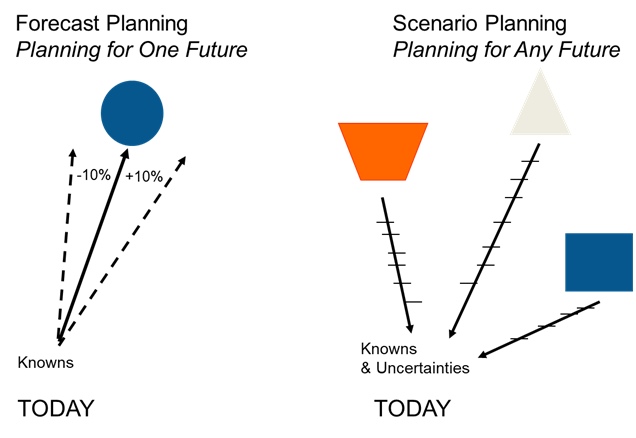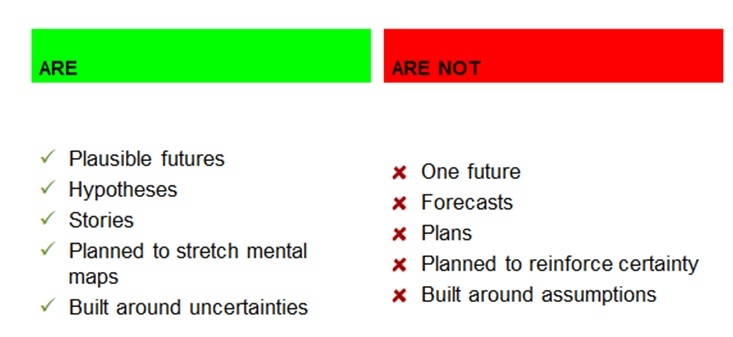Scenario Planning

TM Nagarajan
Managing Partner
Developing scenarios is more than a theoretical exercise. It is a fundamental, practical and important part of a manager’s role. If managers are not preparing the organisation for the future, its future will be buy replica watches dependent upon hoping that it can respond to changes after they occur.
Changes in competition occur all of the time with takeovers and mergers and global companies deciding to withdraw from, or seek to penetrate, markets. Innovation or the ending of protection of patents, as with the replica uhren schweiz pharmaceutical patents, can have a major impact on how competition in markets develops.
Companies need to be able to analyse markets to identify the key variables that affect both demand and competition. They need to be able to develop scenarios for markets to enable them to consider their impact and to plan for the future as it unfolds. They need to be able to put themselves and their competitors within the dynamic evolving market context of now and the future and to be able to identify the strategic options for their future success. Swiss best replica watches UK + Top 1:1 Fake rolex replica Watches Hot Sale!
What are Scenarios
- Scenarios are rich, data-driven, stories about tomorrow that can drive better decisions today
- Scenarios offer a way to organize and test assumptions about the future despite inherent complexity and uncertainty
- Scenarios provide a framework for recognizing and adapting to change over time—ahead of time
- The goal of scenario planning is not to find certainty but to create a map of uncertainty.
- Scenario planning is designed not to reinforce what you know or assume, but to make visible what you are not seeing.
- It does not provide one right answer about how the future will unfold but will help frame and understand multiple plausible futures.

Hence, Scenarios...

Scenario-based thinking is used in many different ways
- Defining Long-Term Strategy
- Making Decisions Under Conditions of Uncertainty
- Innovating in Anticipation of the Market
- Developing Organizations That Can Think Flexibly and Creatively
- Aligning Stakeholders in Support of a Shared Vision
Scenario Development Approach
Scenario development process holds 4 critical steps. After identifying the driving forces and critical uncertainties for the months or years to come, the goal is to develop 4 distinct scenarios that are most likely to happen. The best way to perform all of these steps is to organize workshops during which all the participants brainstorm together, it will help you find creative solutions.
4 scenarios are not a lot compared to the multitude of possible scenarios but it should be enough to focus on the major issues at stake. The process to create scenarios are quite straight forward. The following are the steps:
Step 1. Identify driving forces:
To begin with, you should discuss what are going to be the big shifts in society, economics, technology and politics in the future and see how it will affect your company. Driving forces generally looks at PESTLE (Political, Economic, Social, Technology, Legal & Environment), Trends (Consumer behaviour, Demand, Buyer, Competitor, Supplier, Distribution and Substitute.) and Internal Company SWOT (Strength, Weakness, Opportunity & Threats)
Step 2. Identify your critical uncertainties:
Once you have identified your driving forces and made it a list, pick up two to four (those that have the most impact on your business). For example, two of the most important uncertainties for agribusiness companies are food prices and consumer demand.
Step 3. Develop a range of plausible scenarios:
The goal is now to form a kind of matrix with your two critical uncertainties. Depending on what direction each of the uncertainties will take, you are now able to draw four possible scenarios for the future.
Step 4. Discuss the implications:
During this final step, you should discuss the various implications and impacts (risk and opportunities) of each scenario and start to reconsider your strategy: set your mission and your goals while taking into account every scenario.
Some pitfalls to avoid
A common trap is to be paralyzed by the multitude of possibilities. Don’t try indefinitely new combinations of uncertainties to build your scenarios. Keep it simple and focus on two to four major uncertainties.
Another common mistake is to believe that you have to choose one particular scenario and build your strategy around it. Scenario planning is not about choosing just one option for the future but rather dealing with all of the possible outcomes to develop a strategy that will stand the test of all scenarios.
Also, when developing your different scenarios, try to not look at the short term that is to say example at your existing market, products or competitors. Do not hesitate to look far ahead, anticipating what the market and competitors are going to be over the next years. In a word, be creative!

Written By
TM Nagarajan/Managing partner





